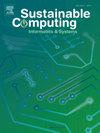在后冠状病毒时期,考虑绿色计算方法,设计可持续的智能供应链
IF 5.7
3区 计算机科学
Q1 COMPUTER SCIENCE, HARDWARE & ARCHITECTURE
引用次数: 0
摘要
本研究旨在提出一个数学框架,用于在 COVID-19 大流行后的时期,由卖方利用物联网(IoT)方法,在库存管理政策下建立智能供应链(SC)和物流,以优化和解决传统供应链面临的挑战。根据需求,提出了一个数学双目标。第一和第二目标是降低 SC 的成本和时间。在这一模型中,考虑了一个四级供应链,实现了从供应商到生产中心、生产中心到销售商、销售商到客户的直接沟通。这个链条的本质是智能链,SC 的各层利用了后 COVID 时代的无线传感器网络(WSN)和射频识别(RFID)、区块链和互联网销售等技术。在本研究中,使用 LINGO 软件的 LP 度量方法验证了中小尺寸模型。建议的大尺寸数学模型需要使用 MATLAB 软件和 Tunicate Swarm 算法(TSA)进行检验。我们简要介绍了我们的贡献和创新亮点。在这种情况下,这是第一项设计可持续智能 SC 的研究,它同时包含了区块链、互联网销售、物联网(包括 RFID 和 WSN)以及后 COVID 时代的所有概念。现简要介绍研究的最终成果:在后 COVID-19 时代,卖家的在线商品销售、生产成本、运输成本和消费者需求都显著增加。本文章由计算机程序翻译,如有差异,请以英文原文为准。
Designing a sustainable and smart supply chain considering a green computing approach in the post-COVID period
The present research aims to present a mathematical framework for a smart Supply Chain (SC) and Logistics under the inventory management policy by the seller using the Internet of Things (IoT) approach in the period following the COVID-19 pandemic for optimizing and solving the challenges of the traditional SC. Based on the needs, a mathematical two-objective was presented. The first and second objectives are to reduce SC's cost and time. In this model, a four-stage SC is considered, which enables direct communication from suppliers to the production centers, production centers to sellers, and sellers to clients. The nature of this chain is smart, and the layers of the SC utilize the technologies of Wireless Sensor Network (WSN) and Radio-Frequency Identification (RFID), blockchain, and internet sales in the post-COVID. In this research, after validating the model using the LP-metric method with LINGO software for small and medium sizes. The suggested mathematical model for the large dimensions needs to be checked using MATLAB software and the Tunicate Swarm Algorithm (TSA). We briefly describe the highlights of contribution and innovation to our knowledge. In that case, this is the first research that designed a sustainable and smart SC that simultaneously encompasses all the concepts of blockchain, internet sales, IoT (including RFID and WSN), and the post-COVID era. The final result of the research is briefly stated: In the post-COVID-19 era, online sales of goods by sellers, production costs, transportation costs, and consumer demand have significantly increased.
求助全文
通过发布文献求助,成功后即可免费获取论文全文。
去求助
来源期刊

Sustainable Computing-Informatics & Systems
COMPUTER SCIENCE, HARDWARE & ARCHITECTUREC-COMPUTER SCIENCE, INFORMATION SYSTEMS
CiteScore
10.70
自引率
4.40%
发文量
142
期刊介绍:
Sustainable computing is a rapidly expanding research area spanning the fields of computer science and engineering, electrical engineering as well as other engineering disciplines. The aim of Sustainable Computing: Informatics and Systems (SUSCOM) is to publish the myriad research findings related to energy-aware and thermal-aware management of computing resource. Equally important is a spectrum of related research issues such as applications of computing that can have ecological and societal impacts. SUSCOM publishes original and timely research papers and survey articles in current areas of power, energy, temperature, and environment related research areas of current importance to readers. SUSCOM has an editorial board comprising prominent researchers from around the world and selects competitively evaluated peer-reviewed papers.
 求助内容:
求助内容: 应助结果提醒方式:
应助结果提醒方式:


